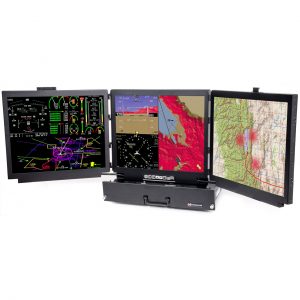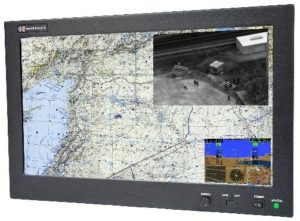Situational Awareness
With the constant emergence of new display technologies in the consumer sector, it is important for program managers and engineers in the military markets to be aware of which and how several of these advances can be incorporated into new military programs to achieve maximum benefit.
Additionally, as older programs present themselves for technological refreshes, it is imperative to understand the difference in display specifications from previous decades, and how updated technology provides avenues for their evolution and continued progress.
It is no secret that the amount of data available to today’s warfighter is staggering. With the number of sources for data ever increasing, from new and more advanced Tactical Data Links, improved mapping and terrain data to advanced weather depiction it becomes even more important to have new and better human interface technology so the information can be quickly digested and decisions be made and acted on.
Modern user terminals have high resolution displays with many enhancements for interfacing with this data. Major trends such as touch screens and enhanced pointing devices, gesture support, biometric authentication and voice recognition are ways to interact with data quickly and securely.
The transition from cathode ray tube displays to early thin film transistor liquid crystal displays occurred rapidly across myriad industries, and the military was no exception. Terminals with multiple display screens, like the three-screen display shown in Figure 1, are seeing transit case deployment in environments where their larger predecessors would never have been taken. The advantages of smaller overall size and decreased power consumption made the transfer an obvious upgrade for a military with a continued focus on rapid tactical capabilities. Current advances in display technology have seen the mass availability of ultra-high-definition (UHD) and 4K displays, and their subsequent hardening for deployment in mobile military use.
The adoption of new technology is rarely without missteps, however. The rugged requirements for deployed electronics quickly shone a light on the weaknesses of many of the early consumer-grade displays and their unsuitability for in-theater use. Environmental and rugged packaging considerations aside, many of the requirements for outdoor display visibility weren’t met in early LCD panels. Under the diffuse fluorescent lights of an indoor office, there are no problems with visibility of on-screen information, but the backlight levels and light polarization in displays that were designed for indoor office use weren’t equipped for the harsher lighting of outdoor environments or compatible with night-vision optics.
The term “sunlight readable” is one phrase that has become popular when referring to displays which incorporate enhancements to off-the-shelf panels to make them more useful in delivering information to the user in adverse lighting conditions, but is hardly specific in describing HOW the display is made readable. Enhancements to a base panel could come in any number of different treatments. Anti-reflective (AR) cover glass, polarizing films, and increased backlight output all serve to make on-screen information more visible to the viewer, but it is important to make note of the fact that while often used interchangeably, a “sunlight readable display” and a “high-bright display” do not always mean the same thing.
A straightforward increase in backlight intensity does not necessarily improve the viewing experience in a bright environment. Even without modification to backlight brightness, dramatic increases to the visibility of outdoor displays can be effected by the proper application of AR coatings and circular polarizing films. These enhancements serve to remove ambient light that is counterproductive to the display on the screen, as well as to adjust the light polarity where it is most functional to the user. Of course, both of these treatments can be applied to a high-bright panel for optimal harsh-environment visibility, as well.
Creating a high-bright display by changing the LED backlight strings in a display panel is a very straightforward and common upgrade that often fits into the same mechanical envelope as the base panel. This simple modification can increase the light output from a panel’s native 300 cd/m2 brightness to 1000 – 2000 cd/m2 or greater. Off the shelf display solutions incorporating these panels are becoming ever-more-ubiquitous in the market, with many manufacturers offering high-bright versions of their standard rugged display product offerings, providing a straightforward solution for military and industrial customers who are working in field environments.
On the alternate range of the spectrum, a similar LED string replacement can equip the identical base panel used in a high-bright modification for use as an NVIS compatible display by changing the LEDs on the backlight strings to versions which are compatible with NVIS optics. Some manufacturers are even offering panels that have NVIS compatibility and sunlight readability in the same panels, as seen in the ruggedized 21.5-inch display in Figure 2. As the volume of information available continues to increase at an exponential rate, display panel manufacturers are continuing to find ways to present the data on displays engineered for a variety of harsh environments.

Large format rugged displays, frequently installed in shipboard applications, are taking advantage of the increased resolution available on large screens to provide more room for more information as well as enhanced clarity of the displayed data. As the information being presented has shifted – from simple alphanumeric text data and low-resolution two-dimensional images to broadcast quality surveillance video and three-dimensional terrain maps – giving tactical advantage in real-time has become a priority for military display functionality. Having higher resolution displays to support it greatly aids in this goal.
No longer content with two dimensional displays, stereoscopic and hologram display technology is on the rise, allowing for presentation of visual data in novel ways. Stereoscopic 3D (S3D) displays take advantage of the binocular disparity of the left and right eyes by sending alternate images to each eye, creating the illusion of a three-dimensional image. This has been true since the first generation of S3D displays, but new methods which combine the temporal and spatial interlacing of images based on color and temporal interlacing looks to improve on early technology, and more importantly how it interfaces with the human eye, to create a more seamless three-dimensional image for the viewer.
Technological advancements in displays have provided the ability to deliver a higher quality product upstream as well. Video interfaces beyond the classic analog-RGB and DVI connections have gained traction in military space where greater fidelity and resolution than standard HD video can provide are required, or when the requirements for multiple displays to run simultaneously are required. One video interface that offers improved functionality when compared to traditional VGA, DVI or HDMI video interfaces are Serial Digital Interfaces.
While classical serial-digital-interfaces (SDI) have been available for nearly 30 years, increased display and digital camera resolutions have required new standards with higher transfer speeds. Original HD-SDI connections provided nominal transfer rates of 1.485 Gb/s, but currently available 3G-SDI interfaces have double that speed, meaning that a single 3G-SDI connection can replace dual-link HD-SDI. These data transfer speeds allow for a large amount of uncompressed and unencrypted video data streams, allowing for true broadcast quality video signals to be displayed on any properly equipped display panel through a simple BNC connector, as seen in the rear panel connections of the high-definition display shown in Figure 3.

With the ability to transmit and display the wealth of available information to warfighters in any number of different scenarios, it logically follows that the methods of interacting with displays and data are going through changes as well. Touchscreens that were once relegated to kiosk and industrial automation lines have found their way into the phones in everyone’s pockets, as well as onto larger format displays on Navy vessels and in aircraft. The number of different touch-capable devices has increased along with the ways of interacting with them. Touchscreen communication and gesture support has grown to include multiple different technologies, including Glass-Film-Glass Resistive Touch, Projected Capacitance with 10-Point Multi-Touch, InfraRed Multi-Touch, and Gesture Recognition, for example.
With advances and enhancements in not only technologies which are intrinsic to displays, but to those which accompany them as well, the presentation of information is becoming increasingly more affective, provided that the correct choices are made when specifying the system. Selecting the correct combination of display attributes for each soldier’s application can seem a daunting task when presented with the number of available options in today’s off-the-shelf military marketplace. Ultimately, the proper selection of displays for each use is going to be dependent on several factors driven largely by the environment in which the display will be used, the type of data required to be displayed, and the requirements for how the user will interface with the displayed data.
